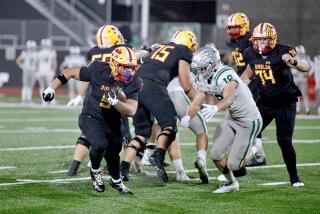
- Share via
JONESBORO, Texas — The people of this Central Texas town leave their homes shortly before dark, heading for the big game, driving along roads that meander through a gray-green countryside of tall grass and brush.
Arriving at an old, pale-stone football stadium, about 30 miles north, they trundle into the stands with coats and blankets to ward off the growing chill.
“Ain’t nobody left back in Jonesboro,” 81-year-old Charles Neatherlin says. “At least we’ve got nothing to rob.”
Their tiny community — a scattering of houses and ranches, a gas station and not much else — has two main reasons to congregate: church and football. Just like during a sermon, the residents fall quiet when their beloved high school team kicks off.
“Oh, we don’t talk,” says Trinity Sanders, who has two sons on the team. “We’re watching.”
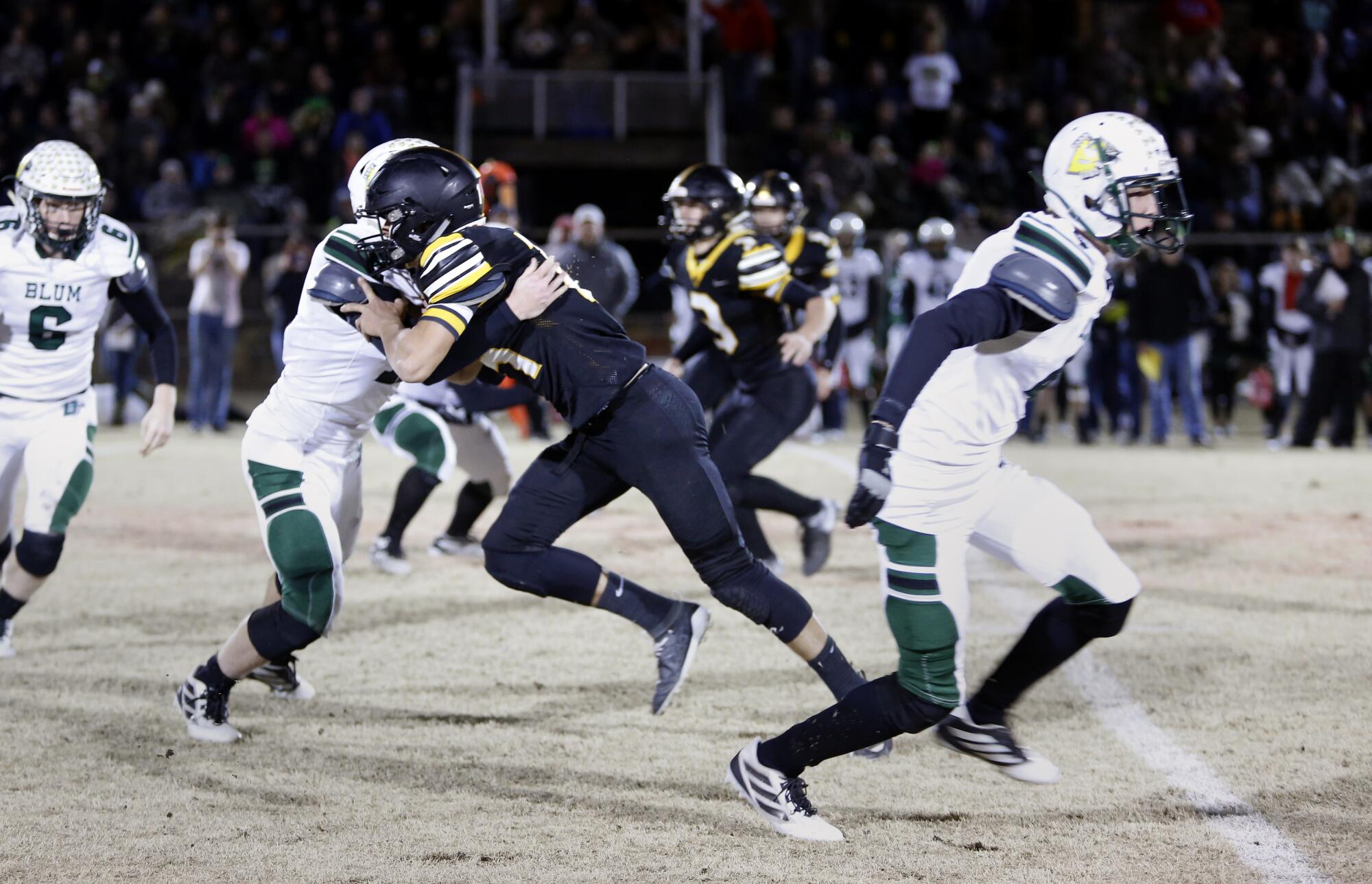
This is the heart of football-crazed Texas, but with a twist. The teams from Jonesboro and Blum are playing a peculiar, frenetic version of the game that has been a savior for country schools too small to field standard 11-man teams. And with participation numbers declining nationwide, it could be on its way to California.
Six-man football is all about wide-open spaces and misdirection plays, the next touchdown a missed tackle away. Everyone on the field is an eligible receiver, so it isn’t unusual to see the center snap the ball, take a few steps and turn to catch a pass.
Nobody punts on fourth down and onside kicks are the norm. Field goals are worth four points and extra-point kicks are worth two.
“You want hard hits and lots of action?” asks Charles “Cowboy” Parks, a fixture on the sideline with his worn cowboy hat and boots. He runs Sixmania, one of several Texas websites that cover the sport. “I’ve been at games where the final score was 118-100.”
The semifinal playoff between the Jonesboro Eagles and Blum Bobcats takes place on a Friday night in December, at a neutral site in the town of Hico. With a trip to the state championship on the line, it isn’t long before Jonesboro fans have reason to cheer.
The Eagles line up with three blockers on the line, a receiver split wide and two players deep in the backfield. A long snap goes to the running back, instead of the quarterback. The running back then pitches to the quarterback, a new kid named Sean Hernandez, who lofts the ball for a touchdown.
Though six-man has an avid following here, Hernandez recalls that when he moved to Jonesboro, the coach from his previous, 11-man school grumbled: “You don’t want go there. It’s not real football.”
The memory causes Hernandez to grin.
“Actually,” he says, “it’s really fun.”
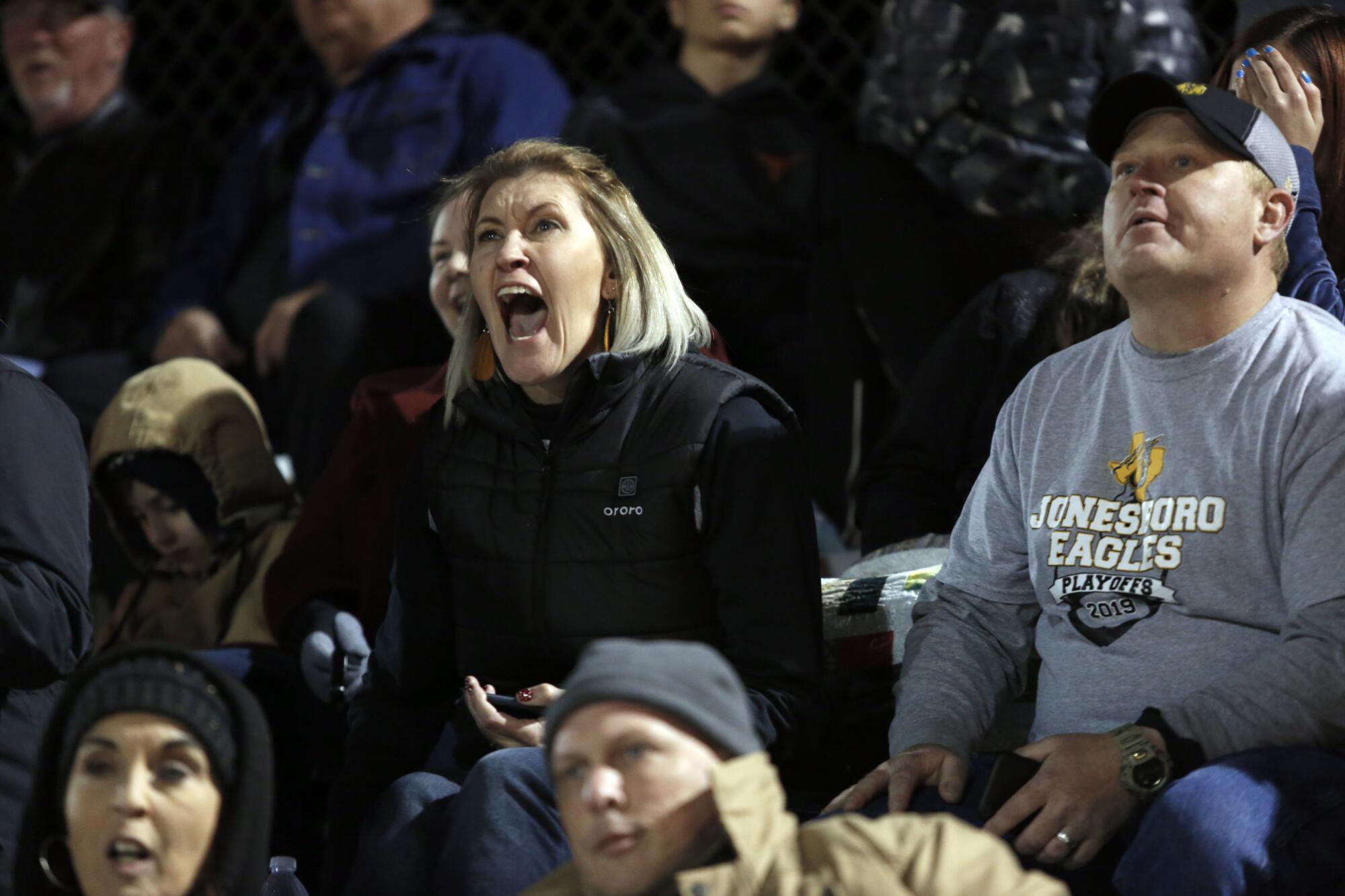
::
Some people call it a cult. Others prefer the word “family.”
They are talking about a connection that runs strong through players, coaches and fans. Six-man is precious to kids who would not otherwise get to play and residents who would not get to root.
Asked to imagine life in Jonesboro without football, Traci Foote twists her lips. A teacher, team parent and head of the booster club, she says: “It would be boring.”
Her high school has fewer than 100 students and there are many like it across the state, tucked away in places nowhere near a major city or even a main highway.
“The railroad was big and now there’s no more trains stopping there,” says Granger Huntress, whose sixmanfootball.com website bills itself as the “bible” of the game. “There’s no industry.”
It was back in the 1930s that a Midwestern teacher named Stephen Epler recognized that towns like these had a need. While taking a graduate education course at the University of Nebraska, he began tinkering with traditional football.
Shrinking the field to 80 yards long and 40 yards wide, Epler decided that first downs should require 15 yards instead of 10. He instituted a mercy rule — a 45-point margin ends the game after the first half — and placed an important limit on running.
Given so much room to maneuver, mobile quarterbacks would dominate, so Epler required at least one exchange — maybe a handoff or pitch — before the ball could be carried across the line. No such restrictions were placed on passes.
“There’s still a lot of running,” Huntress says. “And you get these bursts of scores.”
Eighty-five years after its inception, six-man is played by hundreds of schools, not only in Texas but in states such as New Mexico, North Dakota and Wyoming. The California Interscholastic Federation flirted with the game in the 1930s and made it official for a while in the late 1960s before settling on eight- and 11-man.
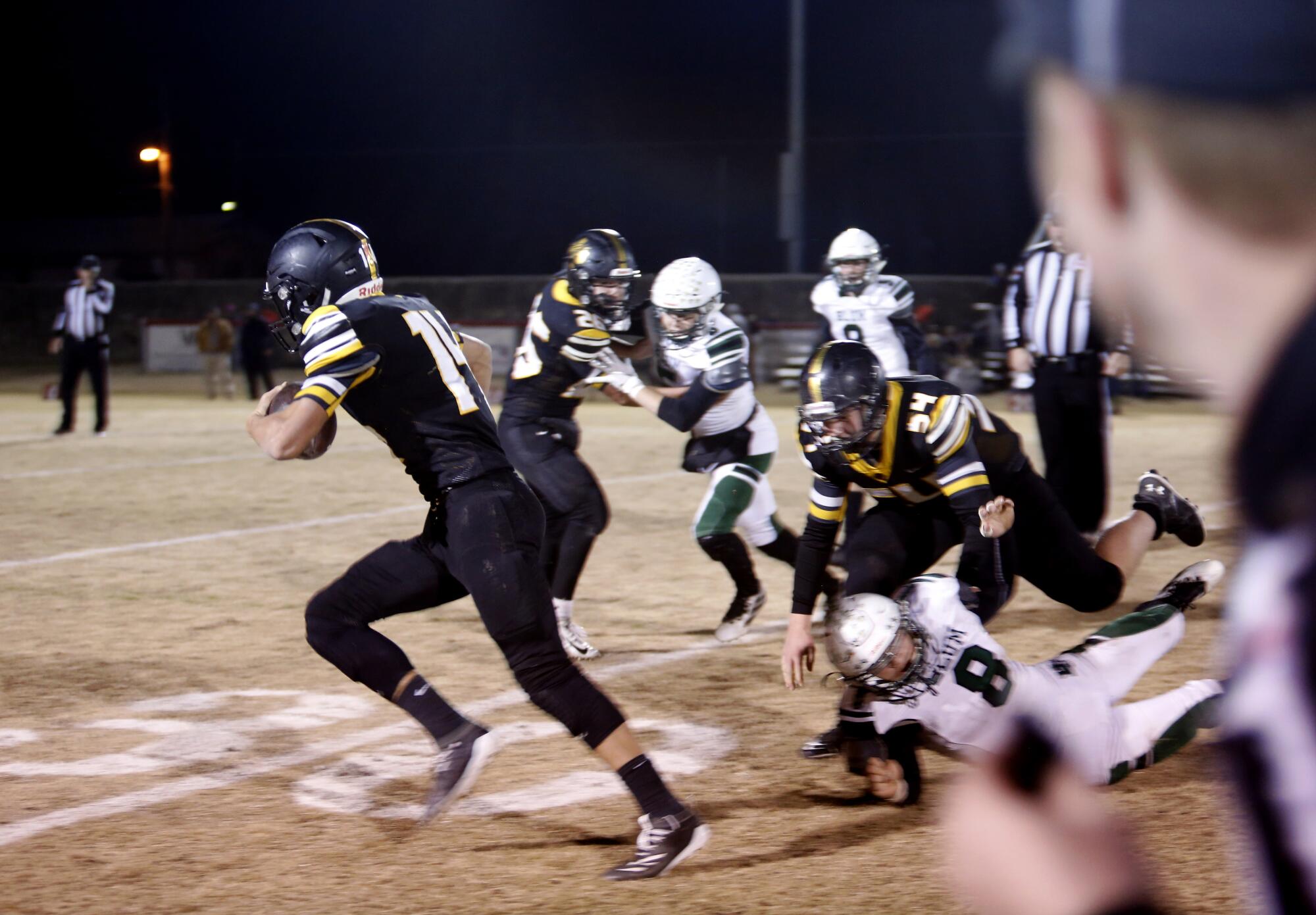
With football participation in the U.S. at its lowest level in two decades, some California schools are struggling to fill those eight-man rosters. The CIF has not discussed returning to six-man, but an official concedes: “To say it won’t be something in the future, who knows?”
::
Two days before the big game, the breeze smells like chimney smoke as Jonesboro players gather for practice, their gold jerseys bright against winter grass turned brown. Goats bleat from pens on a ranch beside campus.
“We’re rural,” coach Eddie Gallegos says. “It’s one of those places where, if the school shut down, there wouldn’t be much left.”
A soft-spoken man who prefaces most responses with “yes sir” or “no sir,” Gallegos played six-man as a boy near Abilene. Now a history and PE teacher with a touch of gray in his beard, he has guided Jonesboro deep into the playoffs three of the last four seasons.
“We’ve got a lot of farm and ranch kids,” he says. “They’re tough. They know how to get after it.”
Though six-man is often referred to as “basketball on grass,” aficionados insist it demands rugged fundamentals, especially blocking and tackling in open space.
There aren’t many 300-pounders because big guys cannot cover ground quickly enough. Linemen must chase down receivers and occasionally run the ball on counter plays. Quarterbacks double as fullbacks, turning to block after they pitch the ball on a sweep.
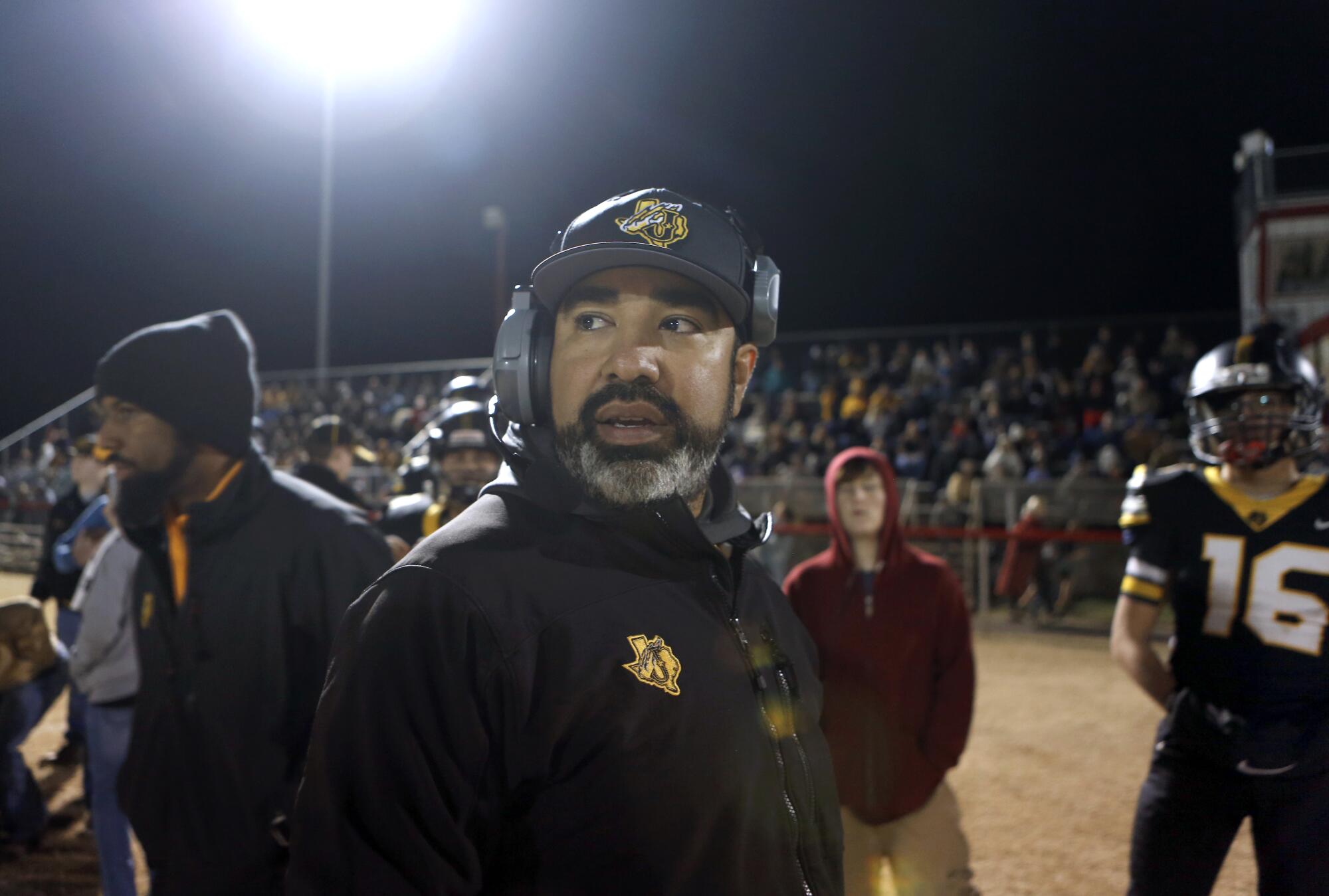
As Jonesboro prepares for Blum, coaches bark and blow their whistles during drills punctuated by thudding bodies and clacking shoulder pads, all of which serves to answer questions about “real football.”
“Yeah, lots of contact,” says Wade Foote, who like most of his teammates plays offense and defense. “There aren’t as many people running around on the field, so they come out of nowhere and hit you hard.”
Even extra-point practice can be daunting. Those short kicks are worth two points — twice as much as usual — because the narrower offensive line cannot keep rushers from streaming in.
“Kicking is huge,” Gallegos says. “A lot of games are won not by the team with the most touchdowns but the team with the most extra points.”
This season, Jonesboro has relied on an exchange student from Denmark, a skinny boy with blond hair who grew up playing soccer. Coming to America, Jeppe Petersen wanted to try football but never imagined all those bodies flying at him. He learned to shorten the standard, three-step approach.
“I take only two,” he says. “I have to get it off quick.”
::
At the six-man level, players tend to be a little slower, a little less-skilled than their counterparts on larger campuses. They don’t specialize in one sport because their schools need them for basketball in winter, then baseball or track in spring. And they rarely get recruited by major colleges.
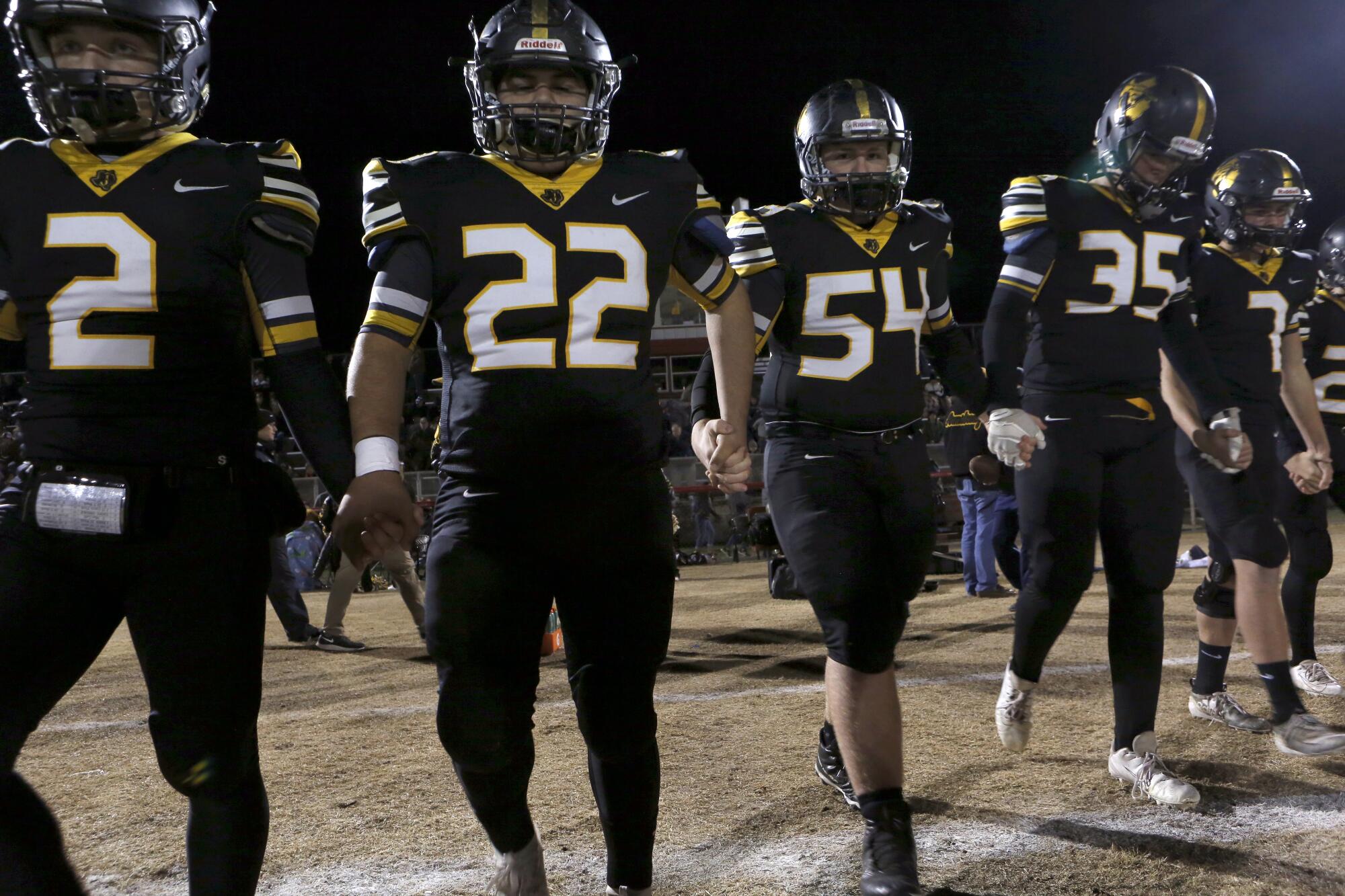
“You can’t tell me an athlete who knows how to tackle and block won’t be productive at Cal Lutheran or Pomona-Pitzer,” Huntress says. “But Division 1? No, you’ve got to set your expectations in the right place.”
So a spot in the state final would be a something special for Jonesboro or Blum. It would mean playing at AT&T Stadium, a Texas shrine that is home to the NFL’s Dallas Cowboys. That might explain a few jitters, a few fumbles, early in their crucial semifinal.
“A game like this,” Gallegos says, “sometimes the kids do get a little nervous.”
The Eagles jump to an early lead with Hernandez throwing that touchdown pass. The quarterback, built square and solid with the focused look of a natural athlete, pitches left for another score a few minutes later as the school’s four cheerleaders bang on their bright yellow megaphones and the band — 20 or so musicians in the top corner of the grandstand — squeak out a version of the White Stripes’ “Seven Nation Army.”
Blum doesn’t panic, pounding away with runs by their big back. Coltin Gonzales charges up the middle for a 23-yard touchdown, and later turns a fourth-down play into a 27-yard score.
Six-man football can look relatively conventional when teams line up with a tightly bunched line, the quarterback under center and two runners behind him.
“Sweeps and dives,” Blum coach Cooper Thornhill says. “The blocking has to be there.”
Still, the quarterback might fake a handoff to one of his backs and slip the ball to a lineman sneaking the opposite direction. In stranger formations, the center crouches alone, with his linemates split to each sideline and a cluster of three men in the backfield. On one such play, Hernandez fakes a run, then shovels a quick chest-pass.
“You have to watch for a lot of things,” he says. “The game is so fast.”
In the second quarter, Blum takes a 22-14 lead and the Jonesboro fans grow antsy. Glenda Pankey, a 71-year-old whose family dates back generations in town, can be heard across the field when she squeals like a dolphin. “My sound,” she calls it.
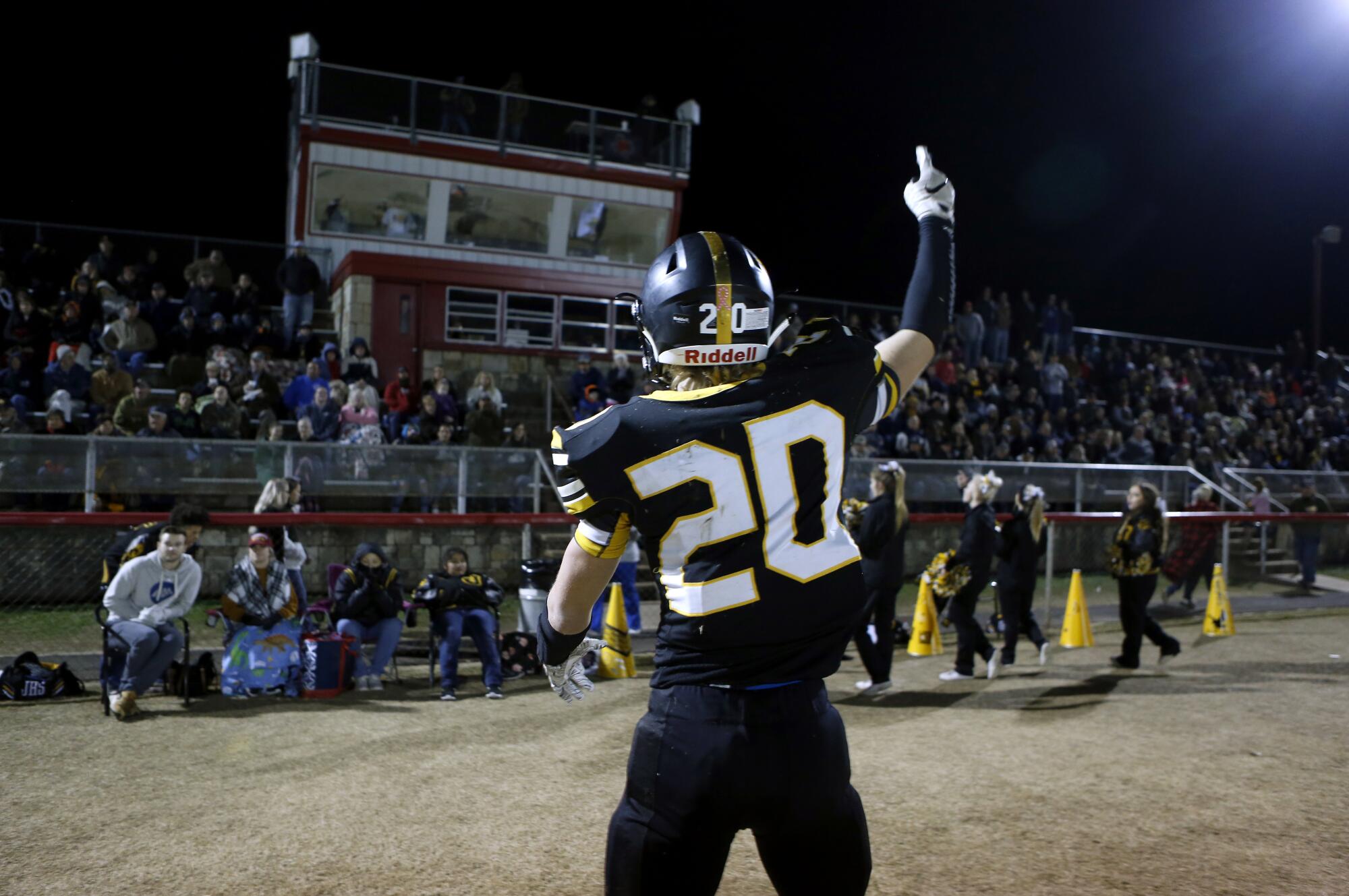
Sanders is just as loud, ringing a yellow cowbell.
“C’mon Eagles,” she shouts. “I’m about to lose it!”
::
Five hundred miles to the north, in Cunningham, Kansas, the high school had gone years without a football team. There simply weren’t enough students in a city whose population had dwindled to about 450.
“People around here missed those Friday night lights,” Coach Lance McGuire says.
When other schools around the state began experimenting with six-man, McGuire went to his school board. As is often the case in places unaccustomed to the game, board members resisted, so McGuire enlisted a couple of six-man coaches from out-of-town to speak at a subsequent meeting.
“You could feel things kind of shift,” he recalls. “The community was thinking, ‘This could be us.’”
The decision was made and everyone pitched in, a local contractor volunteering to rebuild the press box and a welder taking care of the stands at Cunningham’s neglected field. Donors paid for a new scoreboard.
This fall, the home opener was packed.
“Parents, grandparents, relatives and just people who were curious about what six-man looked like,” McGuire says. “We got beat but it was the experience, the atmosphere, the cheerleaders.”
In Oregon, interscholastic officials have seen comparable results with a pilot program involving 21 rural schools. They were concerned about teams beginning the eight-man season with a dozen or so players, then suffering a handful of injuries and forfeiting games at the end.
“We’re in our 12th straight year of declining participation,” says Brad Garrett, an assistant executive director for the Oregon School Activities Assn. “We’re trying to think about football 20 years from now and how can we sustain the sport.”
The two-year trial has gone well enough that officials plan to extend it and add a championship game.
“It’s about getting the trophy,” Garrett says. “There’s a real sense of pride in a community when you have your own team.”
It seems Kansas and Oregon are discovering what Texas already knew — six-man is about more than football.
At Blum, coach Thornhill puts it this way: “If I was broke down in West Texas, I could pick up the phone and call any six-man coach in that area and he would drop whatever he’s doing to come help me.”
::
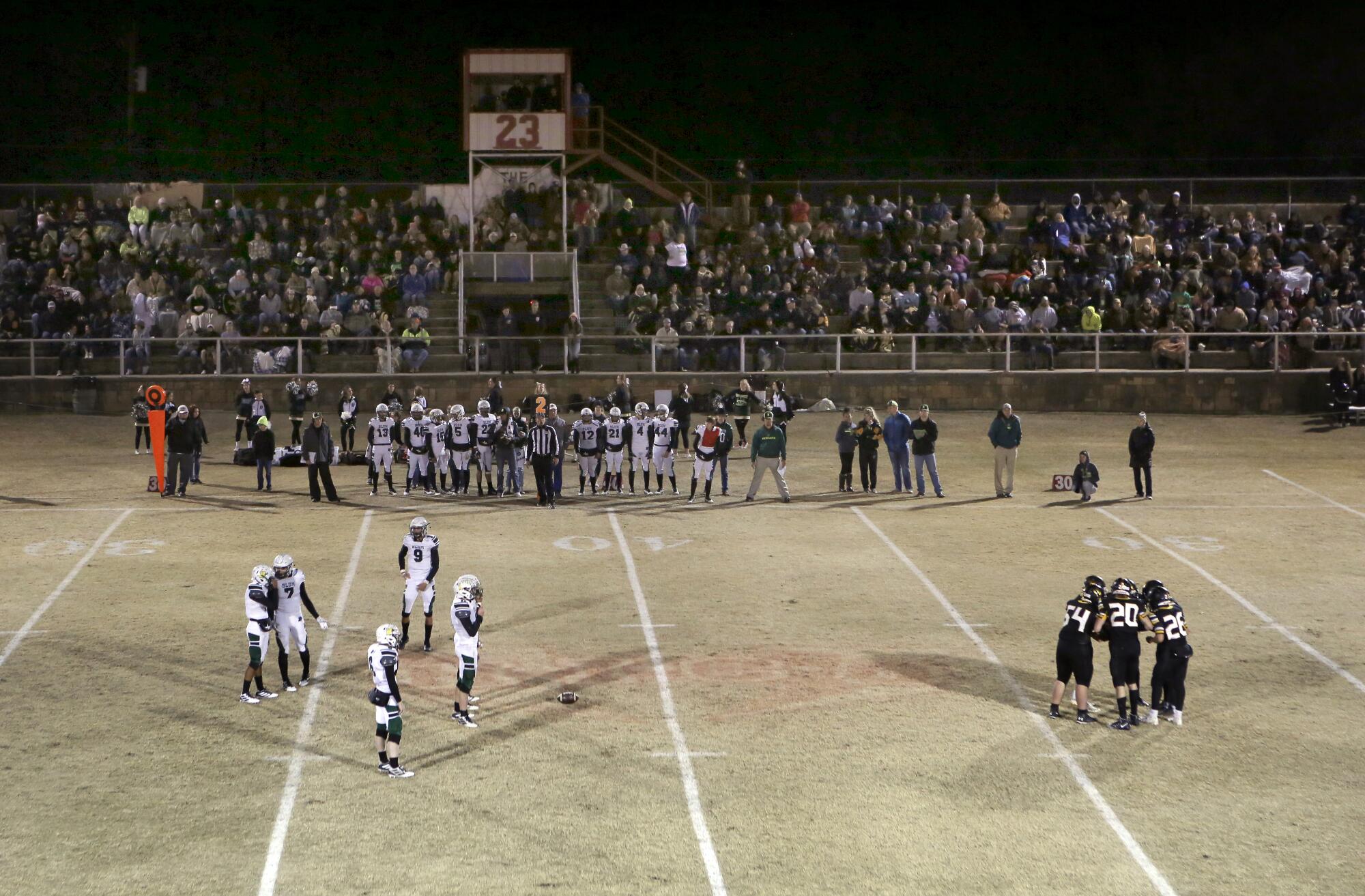
The night air fills with an aroma of meat on the grill, a line forming at the Hico stadium’s barbecue stand. But when the second half begins, most everyone is back in their seats, not wanting to miss a play.
Six-man feels especially intense because of all the scoring; teams need to produce almost every time they touch the ball. That explains the frequent onside kicks.
“You might give up good field position,” Gallegos says. “But, really, you’re always trying to steal a possession.”
Down by two touchdowns, Jonesboro gets the ball to begin the third quarter. Hernandez throws to Foote for 30 yards on the first play, then has a pass dropped in the end zone.
The next play, the Eagles suffer another fumble and Blum responds with three straight runs for a touchdown, stretching the lead to 36-14. Gonzales is on his way to 318 yards rushing for the night.
“Sucker plays hard,” Gallegos says. “We knew it was going to be a chore tackling him.”
As the clock ticks down, Jonesboro resorts to long passes, Hernandez chucking the ball from deep in his backfield. Every time the Eagles manage to reach the end zone, Blum has an answer. The final score is 52-30, sparking a celebration as Blum fans pour onto the field.
“There are so many people rooting for us,” Gonzales says. “Texas revolves around football.”
Away from the clamor, the Jonesboro team gathers quietly. The game’s adrenaline rush begins to ebb, replaced by a realization that the Eagles missed their chance to play in that huge stadium in Dallas. Players duck their heads, many in tears.
The coach doesn’t try to sugarcoat things, telling them this defeat is going to sting.
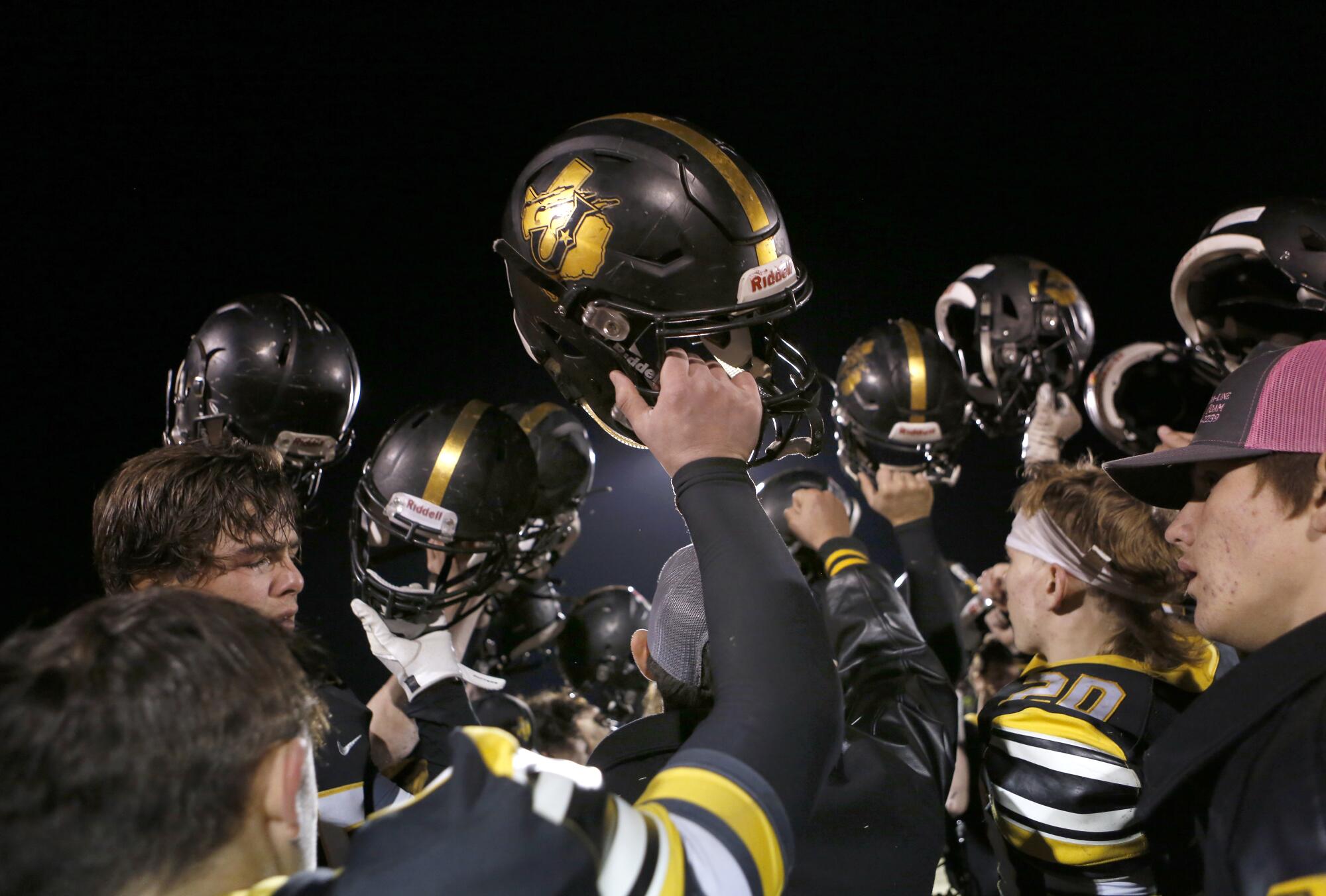
“But when you look back,” Gallegos says, “you’ll be proud.”
Parents, grandparents and neighbors filter down from the stands. There are hugs and pats on the back, a few brave smiles to go with whispered condolences. No one wants to go quite yet.
It will be awhile before the Jonesboro crowd finally drifts away, headed for the far end of the stadium. They leave in the same way they arrived, together.
More to Read
Get our high school sports newsletter
Prep Rally is devoted to the SoCal high school sports experience, bringing you scores, stories and a behind-the-scenes look at what makes prep sports so popular.
You may occasionally receive promotional content from the Los Angeles Times.



